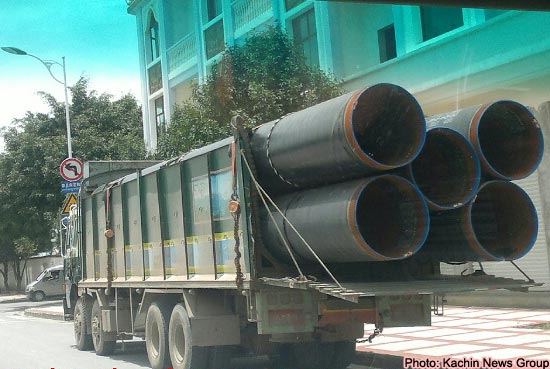A leading oil security expert has weighed in on the potential dangers of operating twin gas and oil pipelines in northern Shan state while fighting between the Burma army and the Kachin Independence Army (KIA) is ongoing near the pipeline route.
 A long stretch of KIA- controlled territory lies along the route of the Shwe gas project's twin oil and natural gas pipelines that are currently under construction. When completed, the pipelines will send gas and oil from Burma's Arakan (Rakhine) coast to China's Yunnan region, a total distance of nearly 800 KM.
A long stretch of KIA- controlled territory lies along the route of the Shwe gas project's twin oil and natural gas pipelines that are currently under construction. When completed, the pipelines will send gas and oil from Burma's Arakan (Rakhine) coast to China's Yunnan region, a total distance of nearly 800 KM.
Although the Shwe Gas Project may not be the primary reason behind the army's offensive against the KIA, observers speculate it has added fuel to the fire.
A security consultant with Westminster International; a firm that provides security for oil and gas projects, told Russia's Interfax news agency last week they had serious concerns about the risks involved with operating the Shwe pipelines while the conflict is ongoing in the region. “We would strongly advise our clients against doing this," said Michael Oxlade.
"Running an over-ground gas pipeline in a location where an armed conflict taking place is absolutely unadvisable; an explosion could easily be caused by a stray bullet. If the pipeline is penetrated it will explode, causing it, and the surrounding area, significant damage."
Since the Kachin conflict restarted on June 9, 2011 fighting has repeatedly broken out near where the pipeline will be built - an area controlled by KIA Brigade 4.
A month before the conflict began; a senior commander for the Kachin Independence Organization (the political wing of the KIA) foretold that the pipeline would be used by the military for its own strategic purposes - to crush ethnic armed groups like the KIO. “The pipeline will be a tool and an opportunity for the SPDC to eliminate the armed groups,” Lt-Gen Gam Shawng told the New York Times back in May of 2009.
Originally the initial pipeline route would have avoided most of the KIO's territory; however in early 2011 the pipeline route in Shan state was significantly altered. Under the old route the pipeline was slated to continue east at Hsipaw and reach Lashio before heading north to Kunming, but under the new route the pipeline makes a near 90 degree turn at Hsipaw heading directly north into KIO territory.
An environmental coalition opposed to the pipeline project has uncovered that two firms hired to produce Environmental, Social and Health Impact Assessments (ESHIA) for both the oil and gas pipelines are Western owned. Activists with The Shwe Gas Movement have repeatedly written letters to the firms asking for copies of the assessments but neither firm has complied.
China National Petroleum Company (CNPC) - the state-owned firm spearheading the consortium that will build and operate pipelines - hired the Hong Kong branch of the UK-based Environmental Resources Management (ERM) to conduct the ESHIA for the oil pipeline, according to Shwe Gas Movement staff. International Environmental Management Co., Ltd. (IEM), a Canadian-owned firm based in Thailand, was also hired.
When the ESHIA was being produced it is unknown whether either of the firms predicted that the pipeline route would be engulfed in fierce fighting between the Burmese government and KIO.



